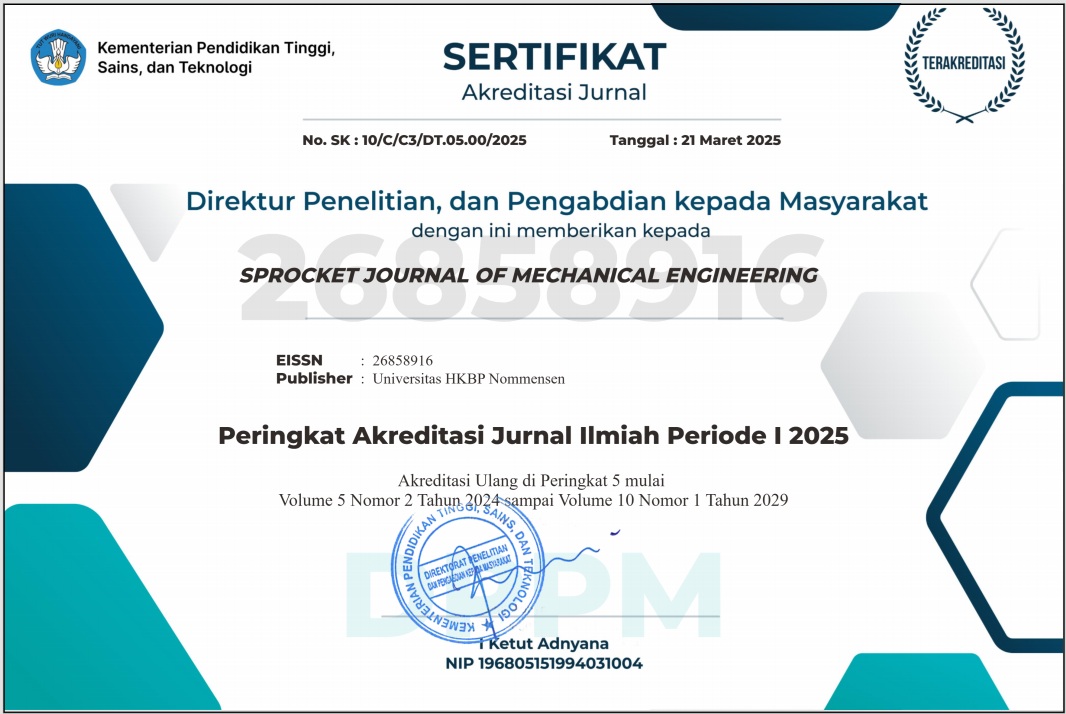Evaluasi Menara Distilasi melalui Program Aspen Hysys
Abstract
PT XXX merupakan pabrik produksi asam formiat pertama dan satu-satunya di Asia Tenggara. Proses produksi yang berlangsung di dalam pabrik terdiri dari dua tahap utama, yaitu tahap pembuatan metil format dan tahap pembentukan asam formiat. Bahan baku utama yang digunakan dalam proses produksi ini diantaranya gas karbon monoksida (CO), metanol (CH3OH), katalis yang berupa kalium metoksida (KOCH3), dan air (H2O). Asam formiat merupakan salah satu bahan kimia yang dapat digunakan untuk kepentingan industri seperti dalam industri karet yaitu sebagai bahan koagulan karet alam dalam industri farmasi,terutama desinfektan obat-obatan dan dipakai sebagai sebagai zat pengawetan dalam industri tekstil digunakan dalam proses drying dan finishing sebagai conditioner, dalam industri kulit digunakan untuk menetralisasi kapur,juga juga digunakan untuk mengasamkan makanan ternak. Maka dari itu diadakannya perbandingan antara simulasi Aspen Hysys dengan perhitungan manual agar mengetahui mana yang paling optimal dan setelah dilakukan keduanya didapatkanlah masih yang berbeda dari hasil keduanya dan yang paling optimal adalah menggunakan perhitungan manual atau menggunakan persamaan neraca massa.
PT XXX is the first and only formic acid production plant in Southeast Asia. The production process that takes place at the plant consists of two main stages, namely the methyl formate production stage and the formic acid production stage. The main raw materials used in this production process are carbon monoxide (CO) gas, methanol (CH3OH), a catalyst in the form of potassium methoxide (KOCH3), and water (H2O). Formic acid is one of the chemicals that can be used for industrial purposes, e.g., in the rubber industry, as a natural rubber coagulant; in the pharmaceutical industry, especially for disinfecting drugs; as a preservative; in the textile industry, as a conditioner in the drying and finishing process; in the leather industry, to neutralize lime; and also to acidify animal feed. Therefore, a comparison was made between the Aspen Hysys simulation and the manual calculations to find out which was the most optimal, and after doing both, it was found that there were still different results from both, and the most optimal was to use the manual calculations or to use the mass balance equation.
References
[2] E. H. Alshbuki, M. M. Bey, and A. Ala. Mohamed, “Simulation production of dimethylether (DME) from dehydration of methanol using Aspen Hysys,” SIJCMS, vol. 03, no. 02, pp. 13–18, Feb. 2020, doi: 10.36348/sijcms.2020.v03i02.002.
[3] P. Santos and T. Van Gerven, “Aspen hysys – unity interconnection. An approach for rigorous computer- based chemical engineering training,” in Computer Aided Chemical Engineering, Milano: Elsevier, 2020, pp. 2053–2058. doi: 10.1016/B978-0-12-823377-1.50343-8.
[4] M. P. Sutardi, M. I. Fardiansyah, F. Fauzia, and D. A. Sari, “Program simulasi Aspen Hysis bagi mahasiswa teknik kimia di semester awal,” in Prosiding Seminar Nasional Universitas Islam Syekh Yusuf, Tangerang: Universitas Islam Syekh Yusuf, Dec. 2020, pp. 1370–1373. doi: 10.31219/osf.io/e3t72.
[5] Q. Smejkal and M. Šoóš, “Comparison of computer simulation of reactive distillation using Aspen Plus and Hysys software,” Chemical Engineering and Processing: Process Intensification, vol. 41, no. 5, pp. 413–418, 2002, doi: 10.1016/S0255-2701(01)00160-X.
[6] D. Sotelo, A. Favela-Contreras, C. Lozoya, F. Beltran-Carbajal, G. Dieck-Assad, and C. Sotelo, “Dynamic simulation of a crude oil distillation plant using Aspen-Hysys®,” International Journal of Simulation Modelling, vol. 18, no. 2, pp. 229–241, 2019, doi: 10.2507/IJSIMM18(2)465.
[7] Z. Azizah and T. K. Dhaniswara, “Integrasi Aspen Plus Dynamics dengan Matlab Simulink (studi kasus: simulasi proses distilasi propana-isobutana),” Journal of Chemical Process Engineering, vol. 6, no. 2, pp. 113–117, 2021, doi: 10.33536/jcpe.v6i2.989.
[8] K. Nadliroh and A. S. Fauzi, “Optimasi waktu fermentasi produksi bioetanol dari sabut kelapa muda melalui distilator refluks,” Jurnal Pendidik Teknik Mesin Undiksha, vol. 9, no. 2, pp. 124–133, 2021.
[9] J. Wibisono, L. Hakim, and N. Za, “Analisa performa kolom distilasi (105D4) di fatty acid plant-1 PT Domas Agrointi Prima dengan simulasi Aspen Hysys,” Chemical Engineering Journal Storage (CEJS), vol. 1, no. 1, p. 1, 2021, doi: 10.29103/cejs.v1i1.4584.
[10] Z. Ma’sum and W. D. Proborini, “Optimasi proses destilasi uap essential oil,” Jurnal Reka Buana, vol. 1, no. 2, pp. 105–109, 2016.
[11] I. Lestari, F. D. Oktavia, A. S. Sanjaya, and Y. Bindar, “Simulasi proses biometil akrilat-air menggunakan metode pressure swing distillation pada Aspen Hysys v8.8,” Jurnal Chemurgy, vol. 3, no. 2, p. 22, 2019, doi: 10.30872/cmg.v3i2.3580.
[12] L. K. Wibowo et al., “Perkiraan biaya modal spesifik atas pabrik multi efek distilasi,” inteka, vol. 7, no. 2, pp. 30–38, 2022, doi: 10.31942/inteka.v7i2.6899.
[13] K. B. A. Walangare, A. S. M. Lumenta, J. O. Wuwung, and B. A. Sugiarso, “Rancang bangun alat konversi air laut menjadi air minum dengan proses destilasi sederhana menggunakan pemanas elektrik,” e-Jurnal Teknik Elektro dan Komputer, vol. 2, no. 2, pp. 1–11, 2013.
[14] T. Sriana, “Pemurnian bioethanol dengan metode distilasi azeotrop,” Konversi, vol. 8, no. 1, pp. 1–3, 2019, doi: 10.20527/k.v8i1.6504.
[15] C. Wang, Y. Zhuang, L. Liu, L. Zhang, J. Du, and Z. Zhang, “Design and control of a novel side-stream extractive distillation column for separating methanol-toluene binary azeotrope with intermediate boiling entrainer,” Separation and Purification Technology, vol. 239, no. 116581, pp. 1–19, 2020, doi: 10.1016/j.seppur.2020.116581.
[16] H. N. Aulia, “Simulasi Aspen Hysys pada kolom absorbsi gas CO2 dengan solven metildietanolamine (MDEA),” Jurnal Teknologi Technoscientia, vol. 14, no. 2, pp. 85–90, 2022, doi: 10.34151/technoscientia.v14i2.3579.
[17] I. A. Fitria, D. A. Sari, V. P. Fahriani, and M. Djaeni, “Shell and tube heat exchanger fouling factor via Heat Transfer Research Inc (HTRI) software,” Reka Buana: Jurnal Ilmiah Teknik Sipil dan Teknik Kimia, vol. 7, no. 2, pp. 104–113, 2022, doi: https://doi.org/10.33366/rekabuana.v7i2.4030.
[18] M. I. Alfath, A. G. Fadzrin, M. I. Kamil, and D. A. Sari, “Praktikum mahasiswa teknik kimia unsika: teori melalui daring dan praktek di normal baru,” in Prosiding Seminar Nasional Universitas Islam Syekh Yusuf, Tangerang: Universitas Islam Syekh Yusuf, Sep. 2020, pp. 1374–1378. doi: 10.31219/osf.io/q2ack.
[19] V. S. Ulfa, H. D. Kharisma, and D. A. Sari, “Optimasi akademisi dan mata kuliah teknik kimia melalui peran praktisi industri,” in Prosiding Seminar Nasional Universitas Islam Syekh Yusuf, Tangerang: Universitas Islam Syekh Yusuf, Dec. 2020, pp. 1379–1383. doi: 10.31219/osf.io/uf45p.
[20] K. P. Ni’mah, F. Fitriah, and D. A. Sari, “Performance of an air-cooled heat exchanger in a separation unit based on fouling factor and pressure drop,” Reka Buana : Jurnal Ilmiah Teknik Sipil dan Teknik Kimia, vol. 8, no. 2, pp. 128–139, 2023, doi: https://doi.org/10.33366/rekabua na.v8i2.4951.
[21] M. Ikhsan Kamil and D. Agustina Sari, “Komparasi desain alat penukar panas tipe air-cooled,” Jurnal Teknologi, vol. 16, no. 2, pp. 180–186, 2023, doi: 10.34151/jurtek.v16i2.4512.
[22] D. A. Sari et al., Top 33 chemical engineering essay competition (part 1). Tasikmalaya: Perkumpulan Rumah Cemerlang Indonesia, 2021. [Online]. Available: https://www.researchgate.net/publication/358356753_Top_33_Chemical_engineering_essay_competition_part_1
[23] M. S. Rumira et al., “Personal competencies of chemical engineering student graduates before entering the world of work,” Jurnal Pendidikan Glasser, vol. 7, no. 2, pp. 423–4300, 2023, doi: 10.32529/glasser.v7i2.2897.

This work is licensed under a Creative Commons Attribution 4.0 International License.
Penulis yang menerbitkan dengan SPROCKET JOURNAL OF MECHANICAL ENGINEERING menyetujui ketentuan berikut :
- Penulis memegang hak cipta dan memberikan jurnal hak penerbitan pertama dengan karya yang dilisensikan secara bersamaan di bawah Lisensi Internasional Creative Commons Atribusi 4.0 . yang memungkinkan orang lain untuk berbagi karya tersebut dengan pengakuan atas kepengarangan karya dan penerbitan awal dalam jurnal ini.
- Penulis dapat membuat pengaturan kontraktual tambahan yang terpisah untuk distribusi non-eksklusif atas versi jurnal yang diterbitkan dari suatu karya (misalnya, mempostingnya ke repositori institusional atau menerbitkannya dalam sebuah buku), dengan pengakuan atas penerbitan awalnya di jurnal ini.
- Penulis diizinkan dan didorong untuk mengunggah karya mereka secara daring (misalnya, di repositori institusi atau di situs web mereka) sebelum dan selama proses penyerahan, karena hal ini dapat mengarah pada pertukaran yang produktif, serta kutipan yang lebih awal dan lebih banyak dari karya yang diterbitkan (Lihat Pengaruh Akses Terbuka ).






.png)
.png)

